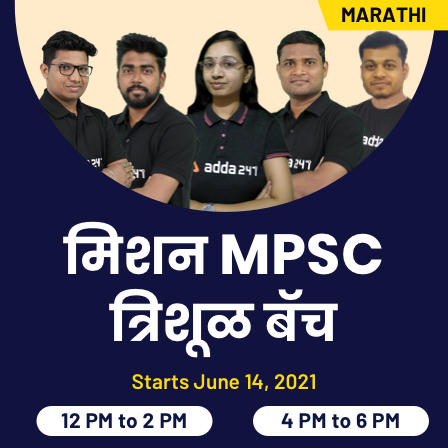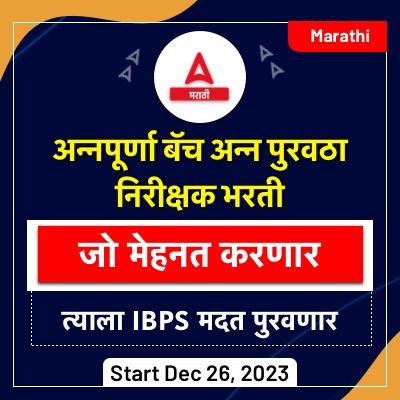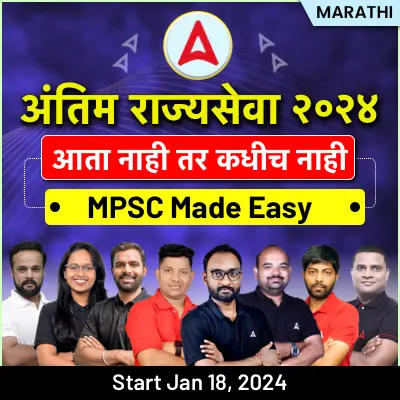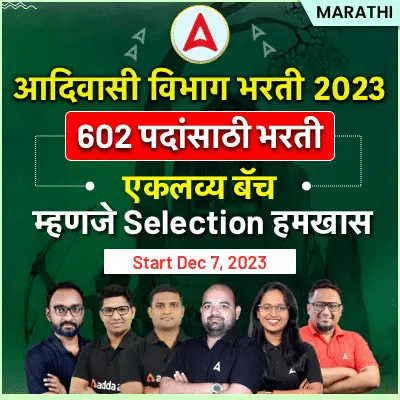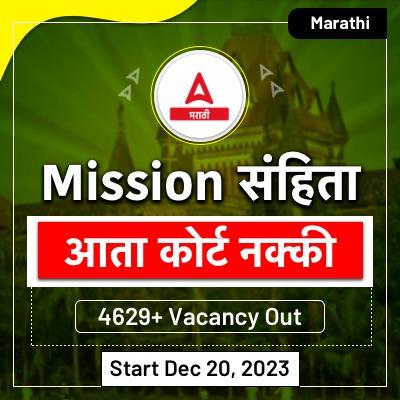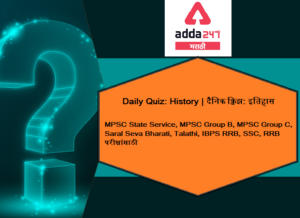
इतिहास दैनिक क्विझ मराठीमध्ये: 4 जून 2021
महाराष्ट्र राज्य लोकसेवा आयोग दरवर्षी वेगवेगळ्या परीक्षे मार्फत हजारो विद्यार्थ्यांची भरती करून घेते MPSC State Service, MPSC Group B, MPSC Group C, Saral Seva Bharati, Talathi, UPSC, SSC, RRB अशा अनेक परीक्षांमार्फत हजारो जागांची भरती दरवर्षी निघते ज्यात लाखो इच्छुक हजार किंवा त्याहूनही कमी जागांसाठी अर्ज करतात. आपण एमपीएससी आणि इतर परीक्षाची तयारी करत असाल तर आपल्याला क्विझ देण्याचे महत्त्व माहित असलेच पाहिजे. बर्याच विद्यार्थ्यांना अभ्यासाचे पुरेसे तास दिले जात असतानाही त्यांना या परीक्षांची पूर्तताही करता आली नाही कारण ते त्यांचे परीक्षण वेळेवर पूर्ण करू शकत नाहीत आणि संशोधन करण्याचा उत्तम मार्ग म्हणजे त्या संबंधित विषयाची किंवा विषयाची क्विझ देणे कारण आपण या मार्गाने कव्हर करू शकता कमी वेळात जास्तीत जास्त विषय. आम्हाला Add 247 मराठी येथे चांगल्या अभ्यास सामग्रीचे मूल्य समजले आहे आणि म्हणूनच आम्ही सर्व विषयांसाठी आपल्याला क्विझ प्रदान करीत आहोत. दैनिक क्विझ देऊन तुम्ही तुमच्या तयारीची पातळी तपासू शकता.
चालू घडामोडी, भूगोल, अर्थशास्त्र, पर्यावरण, सामान्य विज्ञान, इतिहास, पॉलिटी अशा सर्व स्पर्धात्मक सामान्य अभ्यास विषयांमध्ये इतिहासाचाही महत्वाचा वाटा आहे. तर चला इतिहास बद्दल तुमची तयारी तपासण्यासाठी खालील 4 जून 2021 ची इतिहासाची दैनिक क्विझ पहा.
Q1.बॅसिनच्या करारासंबंधी खालील विधानांचा विचार करा
1. ब्रिटिश ईस्ट इंडिया कंपनी आणि बाजी राव द्वितीय, पुण्याचे मराठा पेशवे यांच्यात हा करार झाला
2. दुसऱ्या अँग्लो मराठा युद्धानंतर या करारावर स्वाक्षरी करण्यात आली.
3. या करारानुसार पेशवासयांना सर्व युरोपियनांना त्यांच्या सेवेतून वगळण्यास सांगण्यात आले.
वर दिलेले कोणते विधान/विधाने बरोबर आहे/ आहेत?
(a) 1 आणि 2
(b) 2 आणि 3
(c) 1 आणि 3
(d) 1, 2 आणि 3
Q2. ईस्ट इंडिया कंपनीची चीनमधील व्यापाराची मक्तेदारी (चहा वगळता) संपली-
(a) चार्टर कायदा 1813
(b) चार्टर कायदा 1853
(c) चार्टर कायदा 1833
(d) वरीलपैकी काहीही नाही
Q3. मंदिर प्रवेश चळवळीसंदर्भात खालील विधानांचा विचार करा
1. या चळवळीमुळे ‘निम्न जातीतील लोकांवरील बंदी रद्द करण्याची किंवा तामिळनाडूच्या हिंदू मंदिरांमध्ये प्रवेश करण्याची घोषणा करण्यात आली
2. या चळवळीला महात्मा गांधींनी पाठिंबा दिला होता.
3. वैकोम सत्याग्रह चळवळीची पूर्वतयारी होती
वर दिलेले कोणते विधान/विधाने बरोबर आहे/ आहेत?
(a) 1 आणि 2
(b) 2 आणि 3
(c) 1 आणि 3
(d) 1, 2 आणि 3
Q4. भारतीय सामाजिक परिषदेसंदर्भात खालील विधानांचा विचार करा
1. त्याची स्थापना गोपाल कृष्ण गोखले यांनी केली होती
2. बालविवाहाविरोधात प्रतिज्ञा घेण्यासाठी लोकांना प्रेरणा देण्यासाठी ‘प्रतिज्ञा चळवळ’ सुरू केली.
वर दिलेले कोणते विधान/विधाने बरोबर आहे/ आहेत?
(a) फक्त 1
(b) फक्त 2
(c) दोन्ही 1 आणि 2
(d) 1 किंवा 2 देखील नाही
Q5. वहाबी/वलिउल्ला चळवळीसंदर्भात खालील विधानांचा विचार करा
1. हे उत्तर- पूर्वेकडे बरेलीचे सर सियेद अहमद खान आणि बंगालचे शरियतुल्ला यांनी इस्लामचे शुद्धीकरण आणि बळकटीकरण आणि इस्लामी शिक्षणाला प्रोत्साहन देण्यासाठी सुरू केलेहोते
2. 1857 च्या उठावाच्या वेळी, वहाबीने ब्रिटिशविरोधी भावना पसरविण्यात महत्त्वाची भूमिका बजावली
वर दिलेले कोणते विधान/विधाने बरोबर आहे/ आहेत?
(a) फक्त 1
(b) फक्त 2
(c) दोन्ही 1 आणि 2
(d) 1 किंवा 2 देखील नाही
Q6. अहमदिया चळवळीसंदर्भात खालील विधानांचा विचार करा
1. मिर्झा गुलम अहमद यांनी ही चळवळ सुरू केली
2. कुराण आणि हादीसच्या आधारे इस्लामचे खरे सार शिकवण्यासाठी आणि परकीय राजवटीविरुद्ध जिहाद च्या संकल्पनेचा प्रचार करण्यासाठी सनातनी मुस्लिम उलेमाने उदारमतवादी चळवळीच्या विरोधात ही चळवळ सुरू केली.
वर दिलेले कोणते विधान/विधाने बरोबर आहे/ आहेत?
(a) फक्त 1
(b) फक्त 2
(c) दोन्ही 1 आणि 2
(d) 1 किंवा 2 देखील नाही
Q7. फराईझी मूव्हमेनसंदर्भात खालील विधानांचा विचार कराटी
1. दुडू मियाँ या चळवळीचे संस्थापक होते
2. फराने जमीनदारांशी लढण्यासाठी क्लबसह सशस्त्र निमलष्करी दलाचे आयोजन केले
3. या चळवळीअंतर्गत, त्याने स्वतःची कायदा न्यायालये स्थापन केली.
वर दिलेले कोणते विधान/विधाने बरोबर आहे/ आहेत?
(a) 1 आणि 2
(b) 2 आणि 3
(c) 1 आणि 3
(d) 1, 2 आणि 3
Q8. अहमदिया चळवळीसंदर्भात खालील विधानांचा विचार करा
1. मशिदीला राज्यापासून वेगळे करण्यावर तसेच मानवी हक्क आणि सहिष्णुतेवर त्यांचा विश्वास होता
2. या चळवळीने भारतीय मुस्लिमांमध्ये पाश्चात्त्य उदारमतवादी शिक्षण पसरवला
3. हे सनातनी आणि उदारमतवादी तत्त्वांच्या मिश्रणावर आधारित होते जे सनातनी विचारसरणीवर अधिक झुकते
वर दिलेले कोणते विधान/विधाने बरोबर आहे/ आहेत?
(a) 1 आणि 2
(b) 2 आणि 3
(c) 1 आणि 3
(d) 1, 2 आणि 3
Q9. खालील विधानांचा विचार करा
1. श्री पद्मनाभस्वामी मंदिर चेरा शैलीच्या वास्तुकलेत बांधलेले आहे
2. मुख्य मूर्ती डीईटायभगवान शिव लाल वाळूच्या दगडांनी बनलेला आहे.
वर दिलेले कोणते विधान/विधाने बरोबर आहे/ आहेत?
(a) फक्त 1
(b) फक्त 2
(c) दोन्ही 1 आणि 2
(d) 1 किंवा 2 देखील नाही
Q10. राष्ट्रीय आर्थिक कार्यक्रम मंजूर झालेल्या कॉंग्रेस अधिवेशनाचे अध्यक्ष होते
(a) मोतीलाल नेहरू
(b) जवाहरलाल नेहरू
(c) वल्लभभाई पटेल
(d) सुभाषचंद्र बोस
महाराष्ट्र राज्यातील सर्व स्पर्धा परीक्षांचे मोफत अभ्यास साहित्य
YouTube channel- Adda247 Marathi
App- Adda247 (मराठी भाषा)
Use Coupon code: HAPPY
आणि मिळवा 75% डिस्काउंट
आता तुमच्या घरी लाइव्ह वर्ग मराठीत उपलब्ध आहेत
केवळ सरावच परीक्षेत चांगले गुण मिळण्यास मदत करू शकतो
SBI लिपिक फाउंडेशन बॅच | द्विभाषिक
Solutions
S1.Ans.(c)
Sol.
The Treaty of Bassein (now called Vasai) was a pact signed between the British East India Company and Baji Rao II, the Maratha Peshwa of Pune (Poona) in India after the Battle of Poona. The treaty was a decisive step in the dissolution of the Maratha Empire, which led to the East India Company’s usurpation of the empire’s territories in western India in 1818.
Baji Rao II was restored as Peshwa under the protection of the East India Company and the leading Maratha state had thus become a client of the British. The treaty led to the expansion of the sway and influence of the East India Company over the Indian subcontinent. However, the treaty was not acceptable to all Marathas chieftains and resulted in the Second Anglo-Maratha War.
Under this treaty, peshwas agreed not to keep in his employment Europeans of any nation at war with the English, and (vii) to subject his relations with other states to the control of the English
S2.Ans.(d)
Sol.
S3.Ans.(b)
Sol.
- The movement led to a Proclamation to abolish the ban on the ‘low caste people’ or from entering Hindu temples of Kerala
- This movement was supported by Mahatma Gandhi. Gandhi undertook a tour of Kerala in support of the movement
- Vaikomwere a significant precursor to the temple entry movement. Known as the Vaikom Satyagraha, the protests sought equal rights of access in areas previously restricted to members of upper castes. The protests expanded to become a movement seeking rights of access to the interior of the temples themselves.
S4.Ans.(b)
Sol.
Indian Social Conference Founded by M.G. Ranade and Raghunath Rao, the Indian Social Conference met annually from its first session in Madras in 1887 at the same time and venue as the Indian National Congress. It focussed attention on the social issues of importance; it could be called the social reform cell of the Indian National Congress, in fact. The conference advocated inter-caste marriages, opposed polygamy and kulinism. It launched the ‘Pledge Movement’ to inspire people to take a pledge against child marriage
S5.Ans.(c)
Sol.
S6.Ans.(a)
Sol.
Ahmadiya Movement
This movement was started by Mirza Gulam Ahmed in 1889 in order to spread western education among Indian Muslims. The movement was based on liberal principles, just like Brahma Samaj.
The Deoband School
This movement was started against the liberal movement by the orthodox Muslim Ulema to teach the real essence of Islam on the basis of the Quran and Hadis, and also to preach the concept of Jihad against the foreign rule.
S7.Ans.(b)
Sol.
Faraizi Movement The movement, also called the Fara’idi Movement because of its emphasis on the Islamic pillars of faith, was founded by Haji Shariatullah in 1818. Its scene of action was East Bengal, and aimed at the eradication of social innovations or un-Islamic practices current among the Muslims of the region and draw their attention to their duties as Muslims. Under the leadership of Haji’s son, Dudu Mian, the movement became revolutionary from 1840 onwards. He gave the movement an organizational system from the village to the provincial level with a khalifa or authorized deputy at every level. The Fara’idis organized a paramilitary force armed with clubs to fight the zamindars who were mostly Hindu, though there were some Muslim landlords too, besides the indigo planters. Dudu Mian asked his followers not to pay rent. The organization even established its own Law courts. Dudu Mian was arrested several times, and his arrest in 1847 finally weakened the movement. The movement survived merely as a religious movement without political overtones after the death of Dudu Mian in 1862.
S8.Ans.(a)
Sol.
The Ahmadiyya forms a sect of Islam that originated from India. It was founded by Mirza Ghulam Ahmad in 1889. It was based on liberal principles. It described itself as the standard-bearer of the Mohammedan Renaissance, and based itself, like the Brahmo Samaj, on the principles of the universal religion of all humanity, opposing jihad (sacred war against non-Muslims). The movement spread Western liberal education among the Indian Muslims. The Ahmadiyya community is the only Islamic sect to believe that the Messiah had come in the person of Mirza Ghulam Ahmad to end religious wars and bloodshed and to reinstate morality, peace, and justice. They believed in separating the mosque from the State as well as in human rights and tolerance.
S9.Ans.(a)
Sol.
Sree Padmanabhaswamy Temple is built in the Chera style of architecture, and its main deity, Lord Vishnu is found in the Anantha Shayana posture on Adishesha. The main idol is made of saligram stones, transported from the Gandaki river in Nepal.
S10.Ans.(c)
Sol.
Source: Modern India Class VIII
The President of the Congress session which passed the National Economic Programme was Vallabh Bhai Patel

